Have you been suffering from wrist pain that’s been hindering your daily activities? It could be a scaphoid fracture, a common injury that can significantly impact your wrist’s function and mobility. But fear not, relief is within reach. At the Sydney Orthopaedic Surgeon Clinic, we specialise in providing top-notch care for scaphoid fractures. Our renowned orthopaedic surgeon, Dr Stuart Kirkham, is an expert on scaphoid fractures, known for his acclaimed publication on scaphoid non-unions. Dr Kirkham has published the biggest series in the world on cavitary scaphoid non-unions following more than 25 years of experience in managing a wide range of orthopaedic conditions.
Dr Kirkham’s expertise is unparalleled, and he is dedicated to delivering personalised treatment plans to each patient. When it comes to scaphoid fractures, understanding the intricacies of this delicate bone within your wrist is crucial. Dr Kirkham’s expertise ensures you receive a comprehensive treatment plan that addresses every aspect of your injury thoroughly, helping you achieve a successful recovery.
Don’t let a scaphoid fracture hold you back any longer. The Sydney Orthopaedic Surgeon Clinic, under the guidance of Dr Kirkham, is here to support you on your journey to healing and restoration. Take the first step towards reclaiming your hand’s full functionality and reach out to our friendly team today to schedule a consultation. Let’s work together to get you back to the activities you cherish most.
Anatomy Related To Scaphoid Fractures
The scaphoid bone, aptly named for its boat-shaped appearance, is a vital part of the carpus, or wrist. Nestled at the base of the thumb side, it plays a pivotal role in maintaining the structural integrity of the wrist and facilitating its wide range of motion. The scaphoid bone is an easily identifiable and very unique bone, taking on the shape of a kidney bean.
Surrounding the scaphoid bone is an intricate network of ligaments, tendons, and tissues that collectively form the carpal tunnel. These structures provide crucial support and stability to the wrist joint, allowing for smooth movements during everyday tasks and more complex activities. The scapholunate ligament, in particular, connects the scaphoid to another carpal bone, the lunate, which reinforces the wrist’s intricate mechanics.
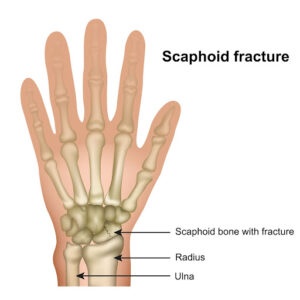
The scaphoid bone plays an important role in both wrist function and mobility, acting as a crucial link between the two rows of carpal bones. In essence, this allows us to make coordinated movements, like those that are important for groping actions. Additionally, it acts as a shock absorber, protecting the wrist from excessive impact during physical activities and ensuring smooth transmission of forces from the hand to the forearm.
Just as a healthy rotator cuff is essential for shoulder function, an intact scaphoid bone is crucial for optimal wrist mobility. Seeking professional care and attention, such as that provided by Dr Kirkham at the Sydney Orthopaedic Surgeon Clinic, ensures that any issues with the scaphoid bone are addressed promptly, allowing you to regain pain-free wrist function and mobility.
Causes and Risk Factors of Scaphoid Fractures
Scaphoid fractures can occur due to a variety of reasons, with some of the most common causes being falls onto an outstretched hand, high-impact sports injuries, and motor vehicle accidents. The scaphoid bone’s location and role in wrist stability make it susceptible to such incidents, especially when the force is directed towards the wrist joint. Athletes engaged in activities like skateboarding, snowboarding, or rugby, as well as individuals with physically demanding occupations, are particularly at risk.
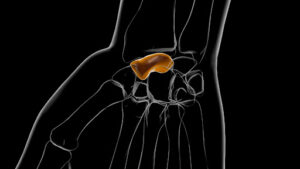
Aside from external factors, certain risk factors can increase the likelihood of sustaining a scaphoid fracture. Age is a significant consideration, as young adults and adolescents engaged in sports or physically active pursuits may be more prone to injuries due to greater exposure to injury and their developing bones. However, older adults may also face increased risks due to age-related bone density changes.
Participation in high-impact or contact sports, such as martial arts or rugby, can elevate the risk of scaphoid fractures. Additionally, pre-existing health conditions like osteoporosis, which weakens bones, can heighten the vulnerability of the scaphoid bone to injuries. Engaging in activities with repetitive stress on the wrist, such as gymnastics or weightlifting, can also contribute to the development of stress fractures in the scaphoid.

Managing and mitigating these risk factors is essential in reducing the likelihood of sustaining scaphoid fractures. Practising proper safety measures during sports and physical activities, such as wearing protective gear or adhering to proper techniques, can significantly decrease the risk of injury. Maintaining a balanced diet rich in calcium and vitamin D is crucial for bone health, particularly in older adults. Engaging in regular weight-bearing exercises can also help improve bone density and overall wrist strength.
By understanding the common causes and risk factors associated with scaphoid fractures, individuals can take proactive measures to protect their wrists from potential harm. Dr Kirkham at the Sydney Orthopaedic Surgeon Clinic always educates each of his patients on the importance of injury prevention, and he provides each of them with personalised advice to help them manage their own risk factors effectively. Seeking his expertise and guidance can lead to safer wrist activities and ultimately promote better wrist health and overall well-being.
Symptoms and Identification of Scaphoid Fractures
Recognising the symptoms of a scaphoid fracture is crucial for early intervention and proper treatment because identifying these injuries can be very difficult. Pain associated with these conditions is typically localised at the base of the thumb or on the radial side of the wrist. The pain may intensify with movement or when pressure is applied to the affected area.
However, it’s important to recognise that scaphoid fractures may not always cause a great deal of pain, so be sure to look out for other symptoms. These might include swelling and tenderness around the wrist, and this may be accompanied by limited wrist motion and difficulty gripping objects. In some cases, clearer symptoms and signs of a scaphoid fracture may appear, such as bruising or discolouration. While these are of course unfavourable, they make for a much easier identification process.
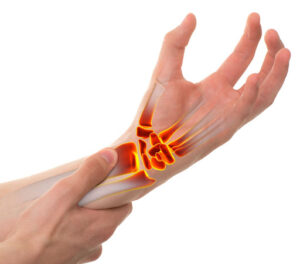
The severity of symptoms can vary depending on the extent of the injury. In cases of mild fractures, the pain and swelling might be subtle, leading some individuals to dismiss the injury as a sprain or strain. However, even mild symptoms should not be ignored, as untreated scaphoid fractures can lead to serious complications, such as avascular necrosis.
Identifying a scaphoid fracture early is essential for a successful recovery. If you have experienced a fall or injury to your wrist and are experiencing persistent pain, swelling, or limited wrist movement, it is crucial to seek immediate medical attention. Delaying treatment can lead to delayed healing, increased risk of complications, and longer recovery times.
If you suspect you may have sustained a scaphoid fracture, Dr Kirkham at the Sydney Orthopaedic Surgeon Clinic is the specialist to turn to. With his extensive experience in orthopaedic care, Dr Kirkham can accurately diagnose the condition and recommend the most appropriate treatment plan for you. Early intervention and tailored management strategies can pave the way for a faster and more complete recovery, ensuring you can get back to your normal activities with confidence. Don’t hesitate to reach out for professional medical assistance and start your journey towards optimal wrist health today.
Diagnosis and Imaging of Scaphoid Fractures
Diagnosing a scaphoid fracture involves a combination of several different diagnostic procedures and imaging techniques which all ensure an accurate and timely assessment is provided. The first step is a thorough physical examination by a skilled orthopaedic specialist, such as Dr Kirkham at the Sydney Orthopaedic Surgeon Clinic. During the examination, he will assess the wrist’s range of motion, identify any areas of tenderness, and look for signs of swelling or bruising. However, it’s important to note that a physical examination alone is often not sufficient to confirm the presence of a scaphoid fracture, especially in the case of subtle hairline cracks where limited pain may be present.
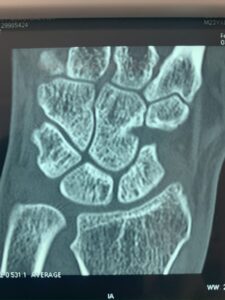
To obtain a more detailed view of the wrist’s internal structures, imaging techniques play a pivotal role in the diagnosis. X-rays are often the first imaging mode that is used, but they can be deceiving in identifying hairline fractures, especially those in the middle of the bone. In these cases, additional imaging methods like CT scans or Technetium 99 bone scans may be necessary. CT scans can assist int his process by providing a range of cross-sectional images of the scaphoid bone, allowing for a more accurate visualisation of the fracture’s location and severity. Bone scans use a radioactive tracer to highlight areas of increased bone activity, and this helps to detect subtle changes in the scaphoid’s blood supply.
Even once the fracture has been identified, it may not heal properly due to the weak blood supply mentioned. Delayed union and even non-union of the joint are not uncommon, and the bone may suffer from insufficient arterial flow, and become necrotic – termed avascular necrosis (AVN) – or dead bone- most commonly at the “proximal pole” or the elbow-end of the scaphoid bone. AVN is typically identified by its bright white and dense appearance on a plain X-ray, and it may display as abnormal in an MRI signal.
Dr Kirkham’s extensive and ongoing research has shown that a precise diagnosis is crucial for forming a personalised treatment plan that addresses the specific needs of each patient. Depending on the fracture’s type, location, and severity, as well as the patient’s age and activity level, the treatment approach may vary. Additionally, early diagnosis can prevent complications like avascular necrosis and allow for prompt initiation of appropriate treatment, contributing to a more successful and swift recovery.
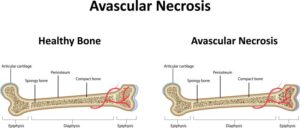
When dealing with a potential scaphoid fracture, seeking expert medical advice and precise diagnosis is essential. That’s why Dr Kirkham and his experienced team are dedicated to providing accurate diagnosis and individualised treatment plans for patients with scaphoid fractures. Don’t hesitate to reach out and schedule a consultation to get the expert care and attention you deserve.
Treatment Options of Scaphoid Fractures
When it comes to treating scaphoid fractures, the approach may vary depending on the fracture type, its location, and the individual patient’s specific needs. For stable fractures with good blood supply, nonsurgical treatment options are often preferred. One common approach is immobilisation through casting or bracing, and this helps to stabilise the bone, promote healing, and prevent further displacement. The cast or brace may need to be worn for several weeks or even months, depending on the fracture’s severity and the patient’s response to treatment.
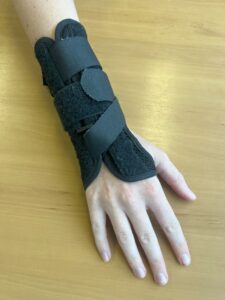
In some cases, physical therapy may also be recommended as part of the nonsurgical treatment plan. Physical therapists can provide exercises to improve wrist strength, range of motion, and overall function. This can be particularly beneficial during the recovery phase, helping patients regain optimal wrist mobility and reduce the risk of stiffness.
For more complex or unstable fractures, surgical intervention may be necessary. Surgery is typically considered in cases of displaced fractures, non-union (failure of the bone to heal), or avascular necrosis (bone death due to inadequate blood supply). When you require on your scaphoid fracture, enlisting the expertise of Dr Kirkham is a wise decision. As a world-renowned orthopaedic surgeon, he has huge experience in treating complex scaphoid fractures, and this has been translated into his academic efforts, in which he has published the largest series in the world on the treatment of cavitary non-unions. Dr Kirkham prefers to use his own technique which is cheap, simple and highly reliable, having achieved a success rate of 97-98%.
Other surgical techniques employed by Dr Kirkham for alternative fracture types may include internal fixation, where screws or pins are used to stabilise the bone fragments, or bone grafting to promote bone healing in non-union cases. The goal of these surgeries is to restore proper alignment and stability to the scaphoid bone, thereby facilitating healing and minimising the risk of long-term complications.
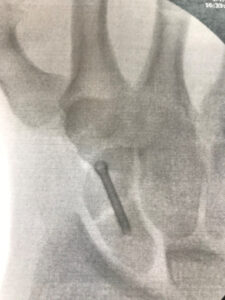
Each patient’s scaphoid fracture is unique, and that’s why a customised treatment plan based on the specific fracture type and patient needs is of the greatest importance. Dr Kirkham understands the significance of personalised care, and he tailors his treatment plans to address individual circumstances. With his expertise and dedication to research and innovation, Dr Kirkham ensures that all of his patients receive the best possible care for their scaphoid fractures. Take the first step in your recovery and contact Dr Kirkham for an expert opinion on the treatment plan best suited to your scaphoid fracture today.
Prevention and Aftercare of Scaphoid Fractures
Preventing scaphoid fractures is most effective when a number of proactive measures are observed, especially for those individuals engaged in high-risk activities. Wearing protective gear like wrist guards during sports like skateboarding, snowboarding, or rugby, can significantly reduce the impact force on the wrist in case of a fall. Practicing proper techniques and warm-up exercises before engaging in physically demanding activities can also be effective in minimising the risk of injury.

After receiving treatment for a scaphoid fracture, follow-up appointments are essential to monitor the healing progress and ensure that the wrist is recovering as expected. Dr Kirkham always emphasises the importance of regular follow-ups to ensure any concerns are addressed promptly, making sure no unfortunate complications develop unnoticed. Additionally, aftercare plays a crucial role in the recovery process. Physical therapy often forms an important part of those process by gradually strengthening the wrist and restoring its range of motion. Following all prescribed rehabilitation exercises typically leads to a quicker and more complete recovery.
Patient responsibility is crucial in ensuring a successful recovery from a scaphoid fracture is experienced. Adhering to the treatment plan, whether it involves wearing a cast, attending physical therapy sessions, or taking prescribed medications, is key. Every precaution should also be taken to avoid any activities that may strain or reinjury the wrist during the recovery period. Dr Kirkham will always provide guidance and support throughout the healing process, but patients must actively participate in their recovery journey to ensure they achieve the best possible outcome.

With the right prevention strategies, diligent aftercare, and active patient involvement, patients can significantly reduce their risk of sustaining a scaphoid fracture. However, if a fracture is sustained, the expert care and support from Dr Kirkham can ensure a smooth recovery process for the patient, helping then return to their daily activities with confidence.
The Recovery Process For Scaphoid Fractures
Recovery from any scaphoid fracture is a gradual process that can vary depending on the fracture’s severity, the chosen treatment approach, and individual factors. Typically, the initial healing phase lasts for about 6 to 12 weeks. During this period, patients with stable fractures may have their wrist immobilised in a cast or brace to allow the bone to heal properly. Regular follow-up appointments with Dr Kirkham are essential at this time to monitor progress and make any necessary adjustments to the treatment plan.
Once the initial healing phase is complete, the next stage focuses on rehabilitation. This period is crucial in restoring wrist strength, flexibility, and overall function. Physical therapy plays a crucial role in this aspect of recovery. Under the guidance of a skilled therapist, patients engage in specific exercises and activities to gradually improve wrist mobility and strengthen the surrounding muscles.
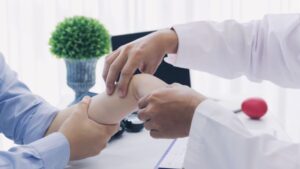
Throughout the rehabilitation phase, patients gradually increase the intensity and complexity of their exercises, working towards achieving normal wrist function. The duration of this phase can vary depending on individual progress and the type of injury. Some patients may experience quicker improvements, while others may require more time to achieve full recovery.
Recovery from a scaphoid fracture is a journey that demands patience, dedication, and cooperation with medical professionals. The comprehensive care provided by Dr Kirkham and his team ensures that each patient receives the personalised attention they deserve throughout the recovery process. Dr Kirkham’s expertise, coupled with his dedication to research and innovation, helps his patients navigate the phases of healing with confidence.
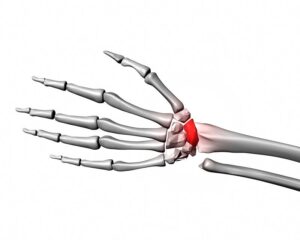
Understanding the typical timeline for recovery and embracing the various phases of rehabilitation empowers patients to actively participate in their recovery journey. By adhering to the prescribed treatment plan and engaging in the recommended rehabilitation activities, patients increase their chances of achieving a successful and complete recovery from a scaphoid fracture, allowing them to resume their daily activities with restored confidence and mobility.
Possible Complications of Scaphoid Fractures
Leaving a scaphoid fracture untreated or receiving improper treatment can result in various complications, with avascular necrosis being one of the most significant risks. Without prompt intervention, the blood supply to the fractured area can become compromised, leading to the death of bone tissue and subsequent degeneration of the joint. Avascular necrosis not only causes persistent pain and limited wrist mobility but also increases the chances of developing arthritis in the affected joint over time.
Dr Kirkham’s great experience and expertise in treating scaphoid fractures play a vital role in minimising these risks. With his intimate knowledge of the scaphoid bone’s unique anatomy and the various factors that influence its healing, Dr Kirkham can accurately diagnose the fracture and recommend the most suitable treatment approach. His dedication to research and continuous learning ensures that his patients benefit from the latest advancements and techniques in orthopaedic care.
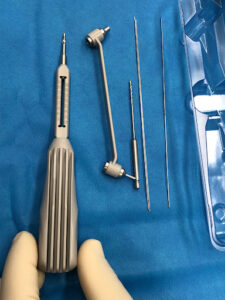
And while all surgical procedures present a risk of infection, Dr Kirkham’s great precaution and adherence to best practices ensures his patients achieve the best possible outcomes for scaphoid fractures. Following Dr Kirkham’s prescribed treatment plan, whether it involves nonsurgical options like casting or surgical intervention, is crucial for successful healing and preventing complications. Patients must actively participate in their recovery by attending follow-up appointments, engaging in physical therapy as advised, and avoiding activities that may jeopardise the healing process.
Dr Kirkham provides personalised care and support to guide patients through every step of their recovery journey. By emphasising the importance of timely treatment, adherence to medical advice, and active patient involvement, Dr Kirkham empowers his patients to take charge of their healing process. With his experience and dedication to achieving the best possible outcomes, patients can rest assured that they are receiving top-notch care and maximising their chances of a successful recovery from a scaphoid fracture.
Are You Concerned About Scaphoid Fractures?
Are you concerned about scaphoid fractures and their potential impact on your wrist health? Don’t let worries and fears hold you back from seeking the help you need. Dr Kirkham, a highly skilled and experienced orthopaedic surgeon at the Sydney Orthopaedic Surgeon Clinic, is here to provide expert care and guidance for all your wrist concerns.
If you’ve experienced a fall, sports injury, or any trauma to your wrist and are experiencing persistent pain, swelling, or limited wrist mobility, seeking professional consultation is crucial. Addressing scaphoid fractures early on can prevent complications and lead to a faster and more successful recovery.

Don’t hesitate to reach out to Dr Kirkham and his dedicated team at the Sydney Orthopaedic Surgeon Clinic. They are ready to provide compassionate and personalised care to address your specific needs. You can schedule a consultation with Dr Kirkham across any of his five conveniently located clinics, with a new Five Dock location recently added to ensure Dr Kirkam can help more of the community. Take the first step towards restoring your wrist health and reclaiming your quality of life.
FAQs
1. What happens if a scaphoid fracture is left untreated?
If a scaphoid fracture is left untreated, it can lead to various complications. One of the most concerning complications is avascular necrosis, where the blood supply to the fractured bone is compromised, causing the bone tissue to die. Avascular necrosis can result in chronic pain, limited wrist function, and the development of arthritis in the wrist joint. Additionally, untreated scaphoid fractures may lead to non-union, where the fractured bone fails to heal properly, leading to persistent pain and instability in the wrist. Delaying treatment can also result in prolonged recovery times and may require more invasive interventions to correct the fracture.
2. How can I promote fast healing of a scaphoid fracture?
To promote fast healing of a scaphoid fracture, it is crucial to seek early and appropriate medical attention. Following the prescribed treatment plan is essential, whether it involves casting, bracing, or surgical intervention. Immobilizing the wrist with a cast or brace allows the bone to heal properly without further displacement. Adherence to physical therapy exercises is vital during the rehabilitation phase, as it helps strengthen the wrist muscles and aids in the recovery process. Adopting a healthy lifestyle with a balanced diet rich in calcium and vitamin D can support bone health and expedite healing.
3. How long does a scaphoid fracture take to heal?
The healing time for a scaphoid fracture can vary depending on factors such as the fracture’s severity, the treatment approach, and individual healing capabilities. In general, stable fractures treated with casting or bracing may take around 6 to 12 weeks to heal. More complex fractures or cases requiring surgical intervention may require a longer recovery period, ranging from 12 weeks to several months. However, it is essential to note that healing times can vary from person to person, and some individuals may experience quicker recoveries while others may require more time. Regular follow-up appointments with Dr Kirkham can help monitor the healing progress and provide necessary adjustments to the treatment plan for optimal recovery.
4. Can scaphoid fractures be misdiagnosed as other wrist injuries?
Yes, scaphoid fractures can be misdiagnosed, particularly if the injury is not immediately obvious or if initial X-rays do not show clear signs of a fracture. In some cases, scaphoid fractures can be mistaken for wrist sprains or strains. Misdiagnosis can lead to delayed treatment and potential complications. As scaphoid fractures require accurate and timely diagnosis, consulting with an experienced orthopaedic specialist like Dr Kirkham is essential to ensure a proper evaluation and appropriate treatment plan for any wrist injury.
5. Are scaphoid fractures more common in certain age groups?
Scaphoid fractures are more common in young adults and adolescents, especially those involved in sports or physically active pursuits. The high prevalence in this age group is often attributed to their adventurous nature and developing bones, which may be more susceptible to injury during high-impact activities. However, scaphoid fractures can also occur in older adults, particularly as age-related changes in bone density may increase the risk of fractures from minor trauma.
References
- Ortho Info (Scaphoid Fracture of the Wrist)
- American Society for Surgery of the Hand (Scaphoid Fracture)
- Cleveland Clinic (Scaphoid Fracture)
- The Royal Children’s Hospital (Scaphoid Fractures – Emergency Management)


